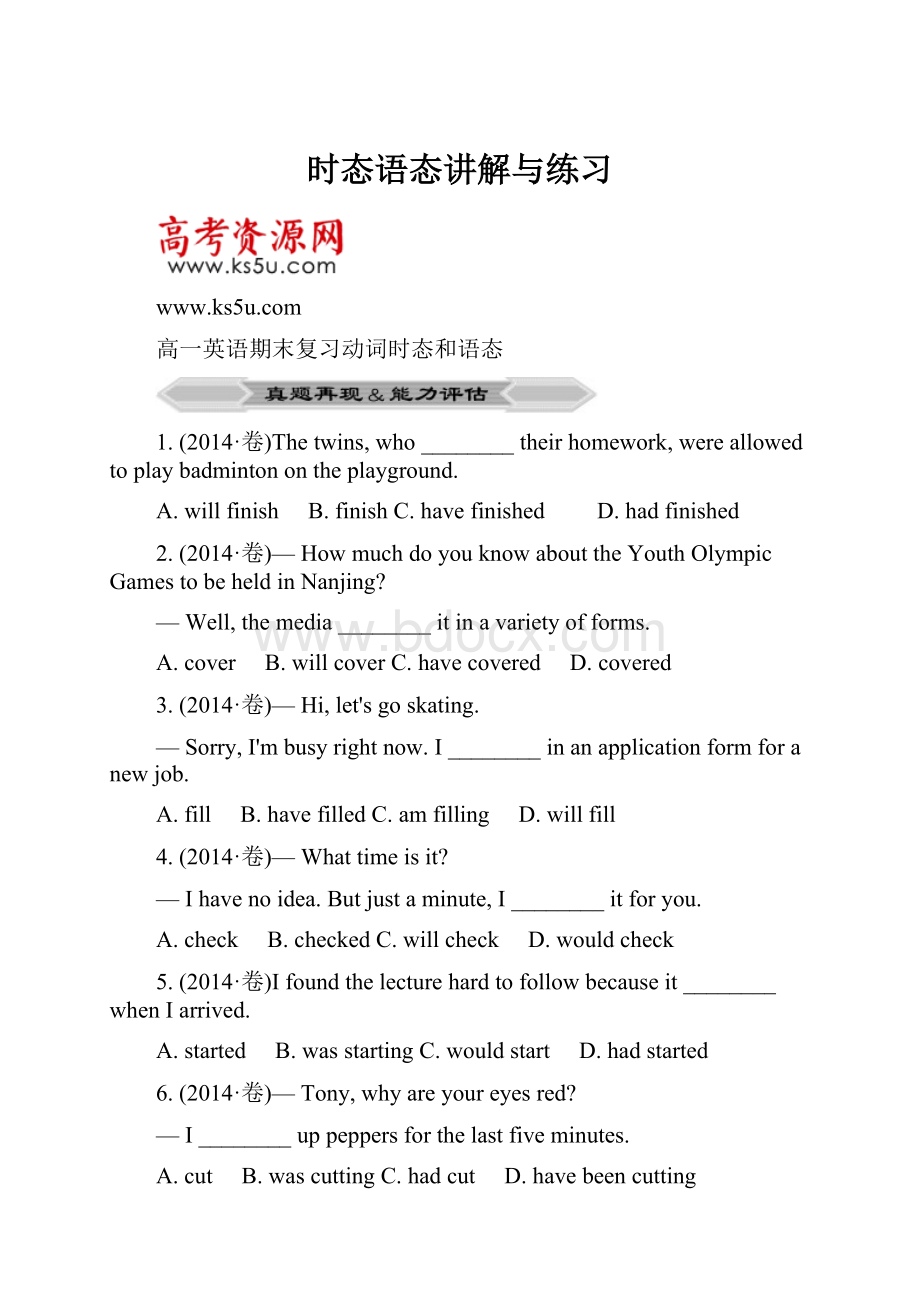时态语态讲解与练习.docx
《时态语态讲解与练习.docx》由会员分享,可在线阅读,更多相关《时态语态讲解与练习.docx(20页珍藏版)》请在冰豆网上搜索。

时态语态讲解与练习
高一英语期末复习动词时态和语态
1.(2014·卷)Thetwins,who________theirhomework,wereallowedtoplaybadmintonontheplayground.
A.willfinish B.finishC.havefinished D.hadfinished
2.(2014·卷)—HowmuchdoyouknowabouttheYouthOlympicGamestobeheldinNanjing?
—Well,themedia________itinavarietyofforms.
A.cover B.willcoverC.havecovered D.covered
3.(2014·卷)—Hi,let'sgoskating.
—Sorry,I'mbusyrightnow.I________inanapplicationformforanewjob.
A.fill B.havefilledC.amfilling D.willfill
4.(2014·卷)—Whattimeisit?
—Ihavenoidea.Butjustaminute,I________itforyou.
A.check B.checkedC.willcheck D.wouldcheck
5.(2014·卷)Ifoundthelecturehardtofollowbecauseit________whenIarrived.
A.started B.wasstartingC.wouldstart D.hadstarted
6.(2014·卷)—Tony,whyareyoureyesred?
—I________uppeppersforthelastfiveminutes.
A.cut B.wascuttingC.hadcut D.havebeencutting
7.(2014·卷)Wewon'tstarttheworkuntilallthepreparations________.
A.arebeingmade B.willbemadeC.havebeenmade D.hadbeenmade
8.(2014·卷)Sofialookedaroundatallthefaces:
shehadtheimpressionthatshe________mostoftheguestsbefore.
A.hasseenB.hadseenC.sawD.wouldsee
9.(2014·大纲卷)Unlessextramoney________,thetheatrewillclose.
A.wasfound B.findsC.isfound D.found
10.(2014·大纲卷)Thereportswentmissingin2012andnobody________themsince.
A.sees B.sawC.hasseen D.hadseen
从近三年来的高考来看,谓语动词的时态命题角度主要有:
直接给出时间状语,学生可以根据其基础知识直接作出相应的解答;所给的时间状语有着较强的干扰性和迷惑性,学生需通过分析语境作出正确选择;句中没有时间状语,学生需通过相关动词并结合语境分析才能作出正确判断;时间、条件、让步状语从句中的“主将从现”转向对从句现在完成时的考核。
几组时态的比较考核是热点:
一般现在时与一般过去时;一般过去时与现在完成时;一般过去时与过去完成时;一般过去时与过去进行时;一般将来时与将来进行时;现在完成时与现在完成进行时;以及将来时不同结构的比较。
要点储备一:
各热点时态的基本概念与高频考点
1.一般现在时
1
表示客观事实或普通真理或格言(不受主句时态限制)
Theteachertoldustheearthmovesaroundthesun.
2
表示现状、性质、状态时多用系动词或状态动词;表示经常或习惯性的动作,多用动作动词,且常与表频率的时间状语连用,如always,seldom,often,frequently,everyday
Icefeelscold.
Wealwayscareforeachotherandhelpeachother.
Heoftenstaysuptillmidnighttocatchupwithothers.
3
表示知觉、态度、感情、某种抽象的关系或概念的词常用一般现在时,如see,hear,smell,taste,feel,notice,agree,believe,like,hate,want,think,belong,seem
Iknowwhatyoumean.
Smithownsacarandahouse.AllthestudentsherebelongtoNo.1MiddleSchool.
4
在时间、条件、方式、让步状语从句中常用一般现在时代替将来时(主将从现)。
但要注意由if引导的条件状语从句中可以用shall(第一人称)或will表“意愿”,但不表示时态
Ifitrainstomorrow,Iwon'tgothere.
Ifyouwillacceptmyinvitationandcometoourparty,myfamilywillbepleased.
5
少数起止的动词,如come,go,leave,arrive,fly,return,start,begin,open,close,end,stop等常用一般现在时代替将来时,表示一个按规定、计划或安排要发生的动作,如课程表、航班表、火车列次表或演出表等,并常与一定的时间状语连用。
另外,当be表示根据时间或事先安排,肯定会出现的状态,也用一般现在时
Theshopclosesat11p.m.everyday.
Myplanetakesoffat10a.m.Thefilmstartsatseveno'clockthisevening.
TomorrowisWednesday.
6
方位副词或介词短语放在句首,主语是名词时,句子全部倒装,用一般现在时表示正在发生的动作
Look!
Therecomesthebus.=Look!
Thebusiscoming.Infrontofthehousesitsalittleboy.
2.一般过去时
1
用于表达过去的习惯或反复发生的动作
Theyneverdrankwine.
2
表示过去的事情、动作或状态,常与表示过去具体的时间状语连用(justnow,lastyear,inthepast,last,after+一段时间,since的从句中,theotherday),或有上下文语境暗示
Imetherinthestreetyesterday.
Ioncesawthefamousstarhere.
3
表示两个紧接着发生的动作,常由以下词语连接:
but,and,when,assoonas,immediately/instantly/directly,themoment/minute/second/instant
Themomentshecamein,shetoldmewhathadhappenedtoher.
Heboughtawatchbutlostit.
HegotdowntoworkimmediatelyhearrivedinShanghai.
4
“刚才”“在过去”,暗示“现在已不再这样”,或表示原来没有想到、预料到的事,常用一般过去时
Whydidn'tyou/Ithinkofthat?
Ididn'tnoticeit.
Ididn'tcatchit.
IforgottotellyouIhadbeentherewithmybrotherbefore.
5
表示现在,用于使说话者的口气委婉,有时带有“试探性”的口气
Iwondered/waswonderingifyoucouldhelpme.
Ithoughtyoumightlikethesebooks.
6
It's(high/about)time(that)+主语+一般过去时
Itistimethatwegotup.
3.现在完成时
1
除可以和for、since引导的状语连用外,还可以和下面的介词短语连用:
during/for/in/overthelast(past)fewyears(months,weeks),inrecentyears/recently/lately,bynow,bythistime,uptonow=tillnow=sofar,severaltimes,yet,already,just等
2
下列句型中常用现在完成时:
Itis(hasbeen)+一段时间+since从句
This/That/Itisthefirst/second/...timethat+主语+现在完成时
This/That/Itistheonly...+that+主语+现在完成时
This/that/Itisthemostinteresting...+that+主语+现在完成时
Thisistheonlymistakethathehasevermade.
Itisthethirdtimethatyouhavevisitedourschool.
3
在时间或条件状语从句中,现在完成时可以代替一般将来时,强调从句动作完成后才发生主句动作
IshallposttheletterassoonasIhavewrittenit.Don'tgetoffthebusuntilithasstopped.
4
短暂动词,即瞬间动词,如join,lose,buy,borrow,leave,go,come,arrive,die,marry,finish,complete,begin,start等,在完成时态中,其肯定式不能和表示一段时间的状语连用,但否定式则可以
注意:
现在完成时与一般过去时的区别:
相同点:
都发生在过去并已结束
不同点:
1.现在完成时表示过去发生的动作或存在的状况,但和现在有联系,强调的是对现在造成的影响或结果,它不能同表示过去的时间状语连用,汉译英时可加“已经”等词。
如:
Ihavealreadyreadthenovelwrittenbytheworld-famouswriter.(已经看过,且了解这本书的容)
2.一般过去时只表示过去发生的动作或状态,和现在无关,它可和表示过去的时间状语连用,汉译英时可加“过”“了”等词。
如:
Ireadthenovellastmonth.(只说明上个月看了,不涉及现在是否记住)IlivedinBeijingfortenyears.(只说明在住过十年,与现在无关)
4.现在完成进行时:
表动作从过去一直延续到现在说话时刚结束或该动作还将进行
1
未完成性和暂时性
区别:
Theyhavebuiltafactory.
Theyhavebeenbuildingafactory.
2
含有一定的感情色彩,有时表示根据直接或间接的证据得出的结论
—Youlookverytired.
—Ihavebeenplayingfootballthewholeafternoon.
3
有少数动词,如work,study,live,teach,stay等,在表示持续一段时间时用现在完成时与现在完成进行时,这两种时态含义差不多(现在完成进行时更强调动作的持续性)
Ihavelived/havebeenlivingheresince1980.
现在完成时与现在完成进行时的区别:
两者都可以表示“从过去开始一直持续到现在”,在含义上如着重表示动作的结果时,多用现在完成时,如着重表示动作一直在进行,即动作的延续性时,则多用现在完成进行时。
一般不能用于进行时的动词也不能用于现在完成进行时。
如:
Ihavereadthatbook.我读过那本书了。
Ihavebeenreadingthatbookallthemorning.我早上一直在读那本书。
5.过去完成时:
表过去的两个动作,如果一个动作发生在另一个动作之前,那么发生在前的就用过去完成时,即“过去的过去”,常用于复合句中,或某些含有虚拟语气的句子中
1
在by,bythen,bythattime,bytheendof,bythetime,until,before,since后接表示过去某一时间的短语,或从句中动词以前发生的动作。
注意下列句型的比较:
Bythetime主语+一般现在时,主语+willhave(been)done...
Bythetime主语+一般过去时,主语+had(been)done...
Itwillbe+一段时间+before+主语+一般现在时
Itwas+一段时间+before+主语+一般过去时
主语+had(been)done/did+before主语+hadtimetodosth./coulddosth.
Bytheendoflastyear,wehadproduced20,000cars.
Thetrainhadleftbeforewereachedthestation.
He(had)rushedoutoftheroombeforeshecouldsayaword.
Bythetimehecomesback,I'llhavefinishedmyhomework.
Bythetimehecameback,Ihadfinishedmyhomework.
Itwillbe3yearsbeforehecomesbackfromabroad.
Itwas3yearsbeforehecamebackfromabroad.
Shesaidshehadmadegreatprogresssincesheenteredtheuniversity.
2
表示未曾实现的希望、打算、意图、诺言等,常用hadhoped/planned/meant/intended/wanted/expected后接不定式的一般式或从句或用上述动词的过去式接不定式完成式表示
Ihadmeanttoseemyuncle,but+主语+过去(进行)时=Imeanttohaveseenmyuncle,but+主语+过去(进行)时=Iwouldliketohaveseenmyuncle,but+主语+过去(进行)时=Iwouldhaveseenmyuncle,but+主语+过去(进行)时=Iwastohaveseenmyuncle,but+主语+过去(进行)时
3
“时间名词+before”在句子中作状语,谓语动词用过去完成时;“时间名词+ago”在句中作状语,谓语动词用一般过去式
Hesaidhisfirstteacherhaddiedatleast10yearsbefore.XiaoHualeftschool3yearsago.
4
表示“一……就”的几个句型:
Hardly/Scarcely+had+主语+过去分词+when/before+主语+一般过去时=Nosooner+had+主语+过去分词+than+主语+一般过去时
Wehadnosoonerbeenseatedthanthebusstarted.=Nosoonerhadwebeenseatedthanthebusstarted.=Hardly/Scarcelyhadwebeenseatedwhen/beforethebusstarted.=Wehadhardly/scarcelybeenseatedwhenthebusstarted.
5
在before或after引导的时间状语从句中用一般过去时代替过去完成时
Afterhe(had)lefttheroom,thebosscamein.We(had)arrivedhomebeforeitsnowed.
注意:
过去完成时与一般过去时区别:
过去完成时强调的是“过去的过去”;如出现同一主语连续几个动作(“连谓”)形式则只用一般过去时即可。
如:
Thelittlegirlcriedherheartoutbecauseshehadlosthertoybearandbelievedshewasn'tevergoingtofindit.
6.现在进行时
1
表示说话时正在发生着的一个动作;表示现阶段但不一定是发生在讲话时;表近期特定的安排或计划;go,come,work,start,leave,stay等起止动作可用进行时代替将来时
HeisteachingEnglishandlearningChinese.
IammeetingMr.Wangtonight.
Heisgraduating.
AtsixIambathingthebaby.
2
与always,often,constantly,continuously等频度副词连用,表经常反复的行为或某种感情色彩
Thegirlisalwaystalkingloudinpublic.
Heisconstantlyleavinghisthingsabout.
3
下面四类动词不宜用现在进行时:
表示心理状态、情感的动作:
like,love,hate,care,remember,believe,want,mind,wish,agree,mean,need;表存在的状态的动词:
appear,exist,remain,seem,belongto,dependon;表示一时性动作的动词:
allow,accept,permit,promise,admit,complete;表示感官的动词:
see,hear,notice,feel,smell,sound,taste,look
7.过去进行时
1
过去某一时刻正在进行的动作或某一阶段发生或频繁发生。
除有上下文暗示外,一般与特定时间状语连用
Hewaspreparinghislecturealldayyesterday.
ThefirsttimeIsawhim,hewasstudyinginhisstudy.
2
某一动作发生时另一动作正在发生,其中一个在由when或while引导的时间状语从句中
Hebrokehislegswhilehewasplayingfootball.
3
表说话人过去对主语行为的赞叹、厌恶等,与always,often,constantly,continuously等频度副词连用
Hewasalwaysblowinghisowntrumpt.老王卖瓜,自卖自夸。
Thenaughtyboywasalwaysmakingtrouble.
4
表示过去将来动作,常用在复合句中
Hesaidshewasarrivingthenextday.
注意:
过去时与过去进行时的区别:
Marywroteanovellastyear.(表完成)Marywaswritinganovellastyear.(表持久进行,未完成)
8.一般将来时
构成
用法
例句
1
will/shall+动词原形
表示将来发生的动作或存在的状态(近、远期);表示一种客观趋向或自然趋势;表示未事先考虑过,即说话时临时作出的决定
Mysisterwillbetennextyear.
Thedoorbellisringing;Iwillanswerit.
2
begoingto+动词原形
含有“打算,计划,即将”做某事(往往经过事先考虑,甚至已作了某种准备);表示有迹象表明很有可能要发生某事;可用于条件句
It'sgoingtoclearup.
We'regoingtohaveapartytonight.
3
be+doing
go,come,start,move,leave,arrive等词可用进行时表示按计划即将发生的动作
Heismovingtothesouth.AretheyleavingforEurope?
4
beaboutto+动词原形
表示安排或计划中的马上就要发生的动作,后面一般不跟时间状语
Iwasabouttoleavewhenthebellrang.
Themeetingisabouttoclose.
5
beto+动词原形
表示按计划进行或征求对方意见;表示吩咐、命令、禁止,可能性等;表示“注定会成为”;可用于条件、时间状语从句中表示“想要”
We'retomeetattheschoolgateatnoon.
Youaretocomebackbefore